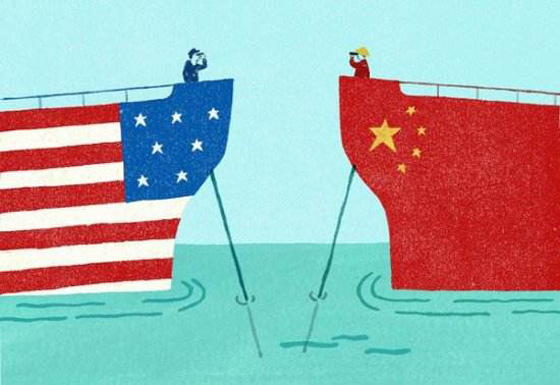
Every time there is a change of administration in either the United States or China, the international media is suddenly filled with speculation over how the interpersonal relations between individual leaders might affect relations between the world’s two most important countries. Such myopic gossip, however, ignores the larger structural, historical, and domestic political forces that ultimately play the leading roles in shaping the dynamics of US-China relations.
The United States and China have had a complex relationship over the past 170 years. Over this long span of time, security and economic dimensions have both been salient. If we look especially at the period since the establishment of the People’s Republic in 1949, China’s relations with the United States were competitive in security terms (with the two countries even facing each other on the battlefield in Korea) and nearly non-existent in economic terms as China pursued a policy of autarky throughout the 1950s and 1960s.
As China’s Third Front strategy and America’s heavy military involvement in Southeast Asia both began to appear unsustainable, each of the two countries came gradually to see the Soviet Union as a much more severe and immediate threat than the other. Thus, by the early 1970s, the United States and China could agree on the beginnings of security cooperation to combat the common enemy of the USSR. Eventually, this arrangement evolved into a framework for normalization of relations by the end of the decade, as China shifted in favor of “reform and opening” and the United States proposed “strategic engagement” as a formula for improving its ties with China.
When Ronald Reagan and Deng Xiaoping were firmly in power during the 1980s, China and the United States were both governed by ruling coalitions that saw deepening engagement with the global economy as a preferred route to economic growth and development at home, even as the Soviet threat remained very much at the forefront of leaders’ minds in both Beijing and Washington. In that climate, both security and economic ties blossomed. This all changed with the collapse of the Soviet Union, however.
During the 1990s, both Jiang Zemin and Bill Clinton kept their countries’ economic focus on greater globalization and ensured that China and the U.S. continued to cooperate on trade and other economic issues. Security cooperation, though, eroded and even came to confrontation – most sharply in the 1995-1996 Taiwan Crisis and in the aftermath of the U.S. bombing of China’s embassy in Belgrade in 1999. The same tensions continued into the early days of the George W. Bush administration, with the EP-3 incident and other disputes very much supplanting economic links, even though the latter were still healthy. Yet, the dynamic changed markedly with the events of September 11, 2001.
After the attacks, China and the United States were soon able to find common ground combatting international terrorism, an area that later expanded to include anti-piracy operations and peacekeeping under UN mandates. American criticism of China’s internal security policies subsided, and China was able to extend its influence in Central Asia with the creation of the Shanghai Cooperation Organization – which, though it had existed since 1996, was greatly enhanced under a new charter signed by its member states in June 2002. This security cooperation only went so far, however, and never came close to the level of relations during the 1980s. At the same time, Hu Jintao’s less enthusiastic embrace of global economic integration for China – at least in comparison with Jiang Zemin – could not sustain the same level of economic ties the U.S. and China had enjoyed under Clinton and Jiang, even as Bush pressed a radically interventionist international agenda generally also coupled with support for free global markets and trade.
Since taking office, Xi Jinping has been focused more squarely on domestic issues and his leadership team has struggled to gain control of international economic forces threatening to weaken China’s economic prospects. In particular, soaring debts, falling growth rates, and increasingly rapid and severe capital flight have combined to threaten social stability and economic development more fundamentally than at any time in the past 20-25 years. Xi’s focus on domestic political, economic, and social issues, alongside ongoing concerns about international markets and trade, have made China less firmly committed to continued globalization than at any time since Deng Xiaoping’s famed Southern Tour.
At the same time, Donald Trump’s unabashed economic nationalism and full-throated protectionist and isolationist rhetoric have ushered in the most introverted U.S. administration since at least World War II. If the White House managed to follow through on even a fraction of what Trump continues to promise, America will have adopted a posture so firmly opposed to globalization and international economic integration that cooperation even with old allies, let alone China, seems unlikely. In this climate, China and the United States appear to be drifting apart economically and potentially headed for confrontation over security issues, as international terrorism, broadly conceived, is proving to be a less than consistent common threat in the minds of elites in both countries.
To put it bluntly, observers can see we’re in trouble when North Korea is the only bright spot of even potential cooperation. Indeed, even on this subject, no concrete actions have been taken (at least publicly) and China and the United States continue to escalate their security competition over matters like the deployment of THAAD to South Korea. China’s declaration of an Air Defense Identification Zone (ADIZ) that covers disputed areas of the East China Sea, angering Japan, has pushed the U.S. closer to a right-wing Japanese government in support of a confrontational response. Taiwan’s politics have helped heighten US-China tensions with the victory of the Democratic Progressive Party in last year’s elections. Meanwhile, claims, counter-claims, threats, and bellicose behavior in the South China Sea have made that region one of the most volatile in the world, with the United States and China on opposing sides of a number of thorny disagreements.
With globalization in retreat and traditional security competition and rivalries rearing to the fore, it would seem as though the world’s most important bilateral relationship is heading imminently for a crisis point. Though this remains an alarming possibility, greater optimism for cooperation is possible in key areas of non-traditional security – such as combatting climate change, cyber-crime, and infectious diseases, as well as terrorism or high-seas piracy. If the United States and China can manage to avoid rapid escalation over Korea, Taiwan, or the South China Sea, while also building bridges on critical non-traditional security issues, there is hope that a more conciliatory relationship might emerge when and if the world economy stabilizes to the greater benefit of both countries’ renewed economic internationalization. Such a temporary holding pattern would be far preferable to a deeper disintegration of ties or, the emergence of a new, and as yet, unknown common enemy, or even worse, renewed strategic rivalry between China and the United States themselves.



